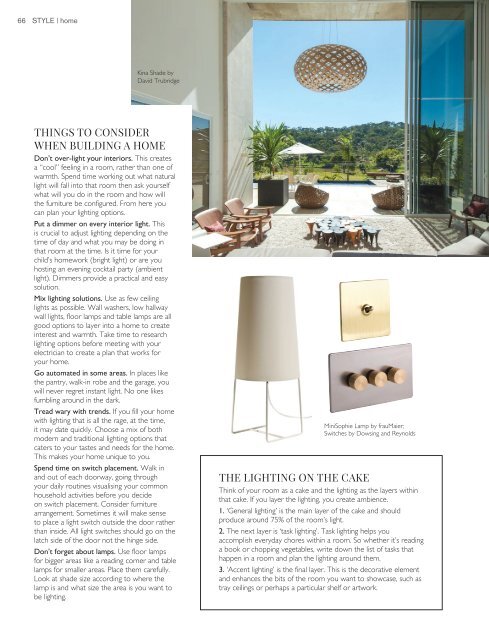Style: August 03, 2018
Create successful ePaper yourself
Turn your PDF publications into a flip-book with our unique Google optimized e-Paper software.
66 STYLE | home<br />
Kina Shade by<br />
David Trubridge<br />
THINGS TO CONSIDER<br />
WHEN BUILDING A HOME<br />
Don’t over-light your interiors. This creates<br />
a “cool” feeling in a room, rather than one of<br />
warmth. Spend time working out what natural<br />
light will fall into that room then ask yourself<br />
what will you do in the room and how will<br />
the furniture be configured. From here you<br />
can plan your lighting options.<br />
Put a dimmer on every interior light. This<br />
is crucial to adjust lighting depending on the<br />
time of day and what you may be doing in<br />
that room at the time. Is it time for your<br />
child’s homework (bright light) or are you<br />
hosting an evening cocktail party (ambient<br />
light). Dimmers provide a practical and easy<br />
solution.<br />
Mix lighting solutions. Use as few ceiling<br />
lights as possible. Wall washers, low hallway<br />
wall lights, floor lamps and table lamps are all<br />
good options to layer into a home to create<br />
interest and warmth. Take time to research<br />
lighting options before meeting with your<br />
electrician to create a plan that works for<br />
your home.<br />
Go automated in some areas. In places like<br />
the pantry, walk-in robe and the garage, you<br />
will never regret instant light. No one likes<br />
fumbling around in the dark.<br />
Tread wary with trends. If you fill your home<br />
with lighting that is all the rage, at the time,<br />
it may date quickly. Choose a mix of both<br />
modern and traditional lighting options that<br />
caters to your tastes and needs for the home.<br />
This makes your home unique to you.<br />
Spend time on switch placement. Walk in<br />
and out of each doorway, going through<br />
your daily routines visualising your common<br />
household activities before you decide<br />
on switch placement. Consider furniture<br />
arrangement. Sometimes it will make sense<br />
to place a light switch outside the door rather<br />
than inside. All light switches should go on the<br />
latch side of the door not the hinge side.<br />
Don’t forget about lamps. Use floor lamps<br />
for bigger areas like a reading corner and table<br />
lamps for smaller areas. Place them carefully.<br />
Look at shade size according to where the<br />
lamp is and what size the area is you want to<br />
be lighting.<br />
MiniSophie Lamp by frauMaier;<br />
Switches by Dowsing and Reynolds<br />
THE LIGHTING ON THE CAKE<br />
Think of your room as a cake and the lighting as the layers within<br />
that cake. If you layer the lighting, you create ambience.<br />
1. ‘General lighting’ is the main layer of the cake and should<br />
produce around 75% of the room’s light.<br />
2. The next layer is ‘task lighting’. Task lighting helps you<br />
accomplish everyday chores within a room. So whether it’s reading<br />
a book or chopping vegetables, write down the list of tasks that<br />
happen in a room and plan the lighting around them.<br />
3. ‘Accent lighting’ is the final layer. This is the decorative element<br />
and enhances the bits of the room you want to showcase, such as<br />
tray ceilings or perhaps a particular shelf or artwork.


















